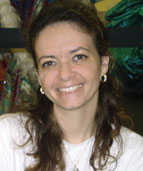Commentary: Karin Fornazier Guimares
 |
| Photo courtesy of Karin Fornazier Guimares |
Twitter: Micro blogging for a macro science network
From the beginning, science and communication have been connected. Writing is a good exercise for inquiring minds; this is not just a saying, but a fact. If you look at scientific biographies, you probably will find mention of a notebook in which the scientist writes down ideas, questions, and quick observations. Those notes give us a perspective on what the scientist was doing at the time.
Today we have not only notebooks, which are usually used to jot down private thoughts, but also blogs in which we can make public all of our work, our ideas, and our opinions. Examples of communities of blogs are Science Blogs, Quantum Diaries, US LHC blogs, Nature Network, and Discover blogs. Some of these were set up as experiments in scientific communication. These blogs are a powerful tool for divulging and discussing scientific research, as discussed a few months ago at ScienceOnline09. But not enough scientists have taken up blogging.
Many more of us could be using this tool to bring science to a different public, in different countries, and across social levels as an opportunity to understand what scientists do day to day. That would translate to more adults interested in science, more high school students interested in science, more girls interested in science, and more people learning the latest news about science from real scientists.
However, science blogging is not an easy task; not everyone is comfortable with writing at such length and in a relatively formal way. To link people who dont want to write so much but still want to share their ideas, why not consider Twitter? It allows a sort of micro blogging in which you describe what youre doing in 140 characters or fewer. How you use this tool is entirely up to you. You can just talk about your life, your tasks, etc., or you can project and promote yourself and your work, letting ideas, insights, difficulties, and achievements flow in a very easy, rapid way. You can point out scientific papers, lectures, and proceedings you find interesting or relevant, as well as blogs with relevant science news and high-level discussion. In this way you can indirectly help a science teacher or novice physicist find the appropriate references for improving their knowledge, tackling school work or demystifying particular issues.
You could also point out some workshop or summer/winter school Web sites that your regular network of colleagues might know about but which other interested people, such as a PhD student from another university, did not know anything about. As you have only 140 characters with which to deliver your message, you will just point it out, and your followers will decide to read or re-tweet (re-broadcast to their followers) your post.
If more scientists start to use it, Twitter can be a tool for developing new relationships, networks, collaborations, and communities. I believe it can help us send messages and get unexpected answers, talk to different kinds of people, and get instant feedback. This makes Twitter a very useful tool. It can allow scientists to make unexpected connections both with other scientists and with other people who are valuable to know and work with.
In my own case, I have used Twitter to meet other scientists, to find out about useful physics information I wouldn't have seen otherwise, and also to practice writing in other languages. How you use Twitter would be up to you, but you might also find it useful for building a network of colleagues around the world who share interests and information, and help make the scientific world better connected.
Karin Fornazier Guimares is a PhD student in particle physics at Instituto Tecnológico de Aeronáutica, SP Brazil. You can follow her as @charmqgp on Twitter. She met the editor-in-chief of symmetry, and they decided to publish this article, through conversations on Twitter. You can read Fornazier Guimares tweets at twitter.com/charmqgp. symmetry tweets as @symmetrymag.
Click here to download the pdf version of this article.


